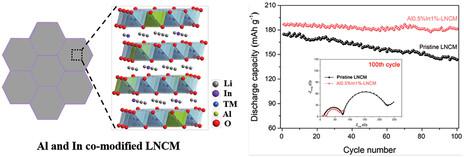当前位置:
X-MOL 学术
›
Adv. Mater. Interfaces
›
论文详情
Our official English website, www.x-mol.net, welcomes your
feedback! (Note: you will need to create a separate account there.)
Aluminum and Indium Co-Modified Ni-Rich Layered Cathode with Enhanced Microstructure and Surface Stability for Lithium-Ion Batteries
Advanced Materials Interfaces ( IF 4.3 ) Pub Date : 2023-09-27 , DOI: 10.1002/admi.202300578
Wen Hu 1 , Yaxin Zhang 1 , Yue Zhao 1 , Rusen Yang 1
Advanced Materials Interfaces ( IF 4.3 ) Pub Date : 2023-09-27 , DOI: 10.1002/admi.202300578
Wen Hu 1 , Yaxin Zhang 1 , Yue Zhao 1 , Rusen Yang 1
Affiliation

|
Ni-rich layered oxides are considered as promising cathodes for next-generation lithium-ion batteries. However, they still suffer microstructure and surface instability particularly under high operating voltage, leading to rapid capacity fading and battery failure. In this context, Ni-rich layered cathodes (LiNixCoyMn1−x−yO2; LNCM) with aluminum and indium co-modified crystal and surface structures are developed by a simple one-pot calcination approach. Battery tests show that the Al and In co-modified LNCM electrodes demonstrate remarkably enhanced rate capability and cycling stability compared with the pristine LNCM, Al-doped LNCM, and In-modified LNCM counterparts. Further characterizations reveal a simultaneous suppression of cracking and resistive film growth. The improved microstructural and surface stability originate from the synergistic functions of Al and In co-modification. The incorporation of Al3+ into transition metal slab significantly reduces the Li+/Ni2+ antisite, which noticeably mitigates the undesired layer to rock-salt phase transformation. The In3+ dopant dispersed in Li interslab can dissipate the anisotropic lattice strain, enabling greatly improved reversibility of H2↔H3 phase transition occurred in delithiation-lithiation processes. Meanwhile, the synchronously formed LiInO2 adherent coatings deplete lithium residues, facilitate lithium-ion transfer, and resist electrolyte corrosion. Microstructure and surface engineering through Al and In co-modification offer a promising design strategy for Ni-rich layered cathodes.
中文翻译:

铝和铟共改性富镍层状正极,具有增强的锂离子电池微观结构和表面稳定性
富镍层状氧化物被认为是下一代锂离子电池有前途的阴极。然而,它们仍然存在微观结构和表面不稳定性,特别是在高工作电压下,导致容量快速衰减和电池故障。在此背景下,通过简单的一锅煅烧方法开发了具有铝和铟共改性晶体和表面结构的富镍层状阴极(LiNi x Co y Mn 1− x − y O 2 ; LNCM)。电池测试表明,与原始 LNCM、Al 掺杂 LNCM 和 In 改性 LNCM 电极相比,Al 和 In 共改性 LNCM 电极表现出显着增强的倍率性能和循环稳定性。进一步的表征揭示了裂纹和电阻膜生长的同时抑制。微观结构和表面稳定性的改善源于Al和In共变质的协同作用。将Al 3+掺入过渡金属板中显着减少了Li + /Ni 2+反位,这显着减轻了不期望的层向岩盐相变的影响。分散在Li板间的In 3+掺杂剂可以消散各向异性晶格应变,从而大大提高脱锂-锂化过程中发生的H2↔H3相变的可逆性。同时,同步形成的LiInO 2粘附涂层会耗尽锂残留物,促进锂离子传输,并抵抗电解质腐蚀。通过 Al 和 In 共改性的微观结构和表面工程为富镍层状阴极提供了一种有前途的设计策略。
更新日期:2023-09-27
中文翻译:

铝和铟共改性富镍层状正极,具有增强的锂离子电池微观结构和表面稳定性
富镍层状氧化物被认为是下一代锂离子电池有前途的阴极。然而,它们仍然存在微观结构和表面不稳定性,特别是在高工作电压下,导致容量快速衰减和电池故障。在此背景下,通过简单的一锅煅烧方法开发了具有铝和铟共改性晶体和表面结构的富镍层状阴极(LiNi x Co y Mn 1− x − y O 2 ; LNCM)。电池测试表明,与原始 LNCM、Al 掺杂 LNCM 和 In 改性 LNCM 电极相比,Al 和 In 共改性 LNCM 电极表现出显着增强的倍率性能和循环稳定性。进一步的表征揭示了裂纹和电阻膜生长的同时抑制。微观结构和表面稳定性的改善源于Al和In共变质的协同作用。将Al 3+掺入过渡金属板中显着减少了Li + /Ni 2+反位,这显着减轻了不期望的层向岩盐相变的影响。分散在Li板间的In 3+掺杂剂可以消散各向异性晶格应变,从而大大提高脱锂-锂化过程中发生的H2↔H3相变的可逆性。同时,同步形成的LiInO 2粘附涂层会耗尽锂残留物,促进锂离子传输,并抵抗电解质腐蚀。通过 Al 和 In 共改性的微观结构和表面工程为富镍层状阴极提供了一种有前途的设计策略。































 京公网安备 11010802027423号
京公网安备 11010802027423号